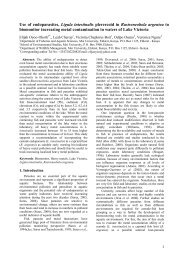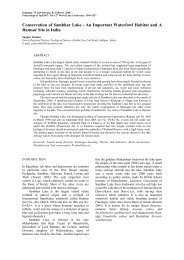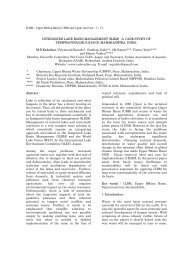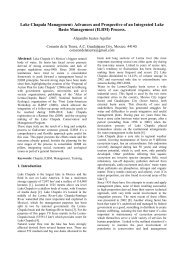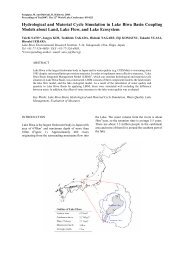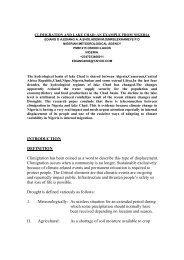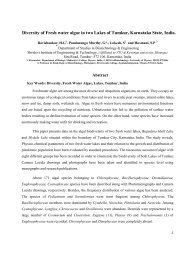Management of Haors, Baors, and Beels in Bangladesh Lessons for ...
Management of Haors, Baors, and Beels in Bangladesh Lessons for ...
Management of Haors, Baors, and Beels in Bangladesh Lessons for ...
Create successful ePaper yourself
Turn your PDF publications into a flip-book with our unique Google optimized e-Paper software.
Annex III<br />
Baikka Beel Wetl<strong>and</strong> Sanctuary<br />
Baikka Beel Wetl<strong>and</strong> Sanctuary is the first <strong>of</strong> its k<strong>in</strong>d <strong>in</strong><br />
<strong>Bangladesh</strong>. Baikka beel is about 100 ha <strong>of</strong> wetlnads <strong>in</strong> the<br />
eastern part <strong>of</strong> Hail Haor near Sreemongal, a tea grow<strong>in</strong>g<br />
town <strong>in</strong> Moulavibazar district about 200 km northeast <strong>of</strong><br />
Dhaka. On 1 July 2003, after a detail plann<strong>in</strong>g process, the<br />
M<strong>in</strong>istry <strong>of</strong> L<strong>and</strong>, Government <strong>of</strong> <strong>Bangladesh</strong> decided to<br />
reserve it as a permanent sanctuary <strong>for</strong> conserv<strong>in</strong>g <strong>and</strong><br />
ma<strong>in</strong>ta<strong>in</strong><strong>in</strong>g biodiversity <strong>and</strong> productivity <strong>of</strong> Hail Haor.<br />
It has s<strong>in</strong>ce been developed as a safe haven <strong>for</strong> fish, birds,<br />
<strong>and</strong> other wildlife. It is a beautiful wetl<strong>and</strong> where thous<strong>and</strong>s<br />
<strong>of</strong> lilies <strong>and</strong> lotus bloom. Bird watchers <strong>and</strong> nature<br />
lovers have begun frequent<strong>in</strong>g it especially <strong>in</strong> w<strong>in</strong>ter. An<br />
observation tower promises the visitors a good view <strong>of</strong> the<br />
beel, its residents <strong>and</strong> w<strong>in</strong>ter visitors.<br />
How Baikka Beel is managed?<br />
Baragang<strong>in</strong>a Resource <strong>Management</strong> Organization (RMO)<br />
compris<strong>in</strong>g <strong>of</strong> 45 villages (fisher, farmers, women <strong>and</strong> local<br />
leaders) looks after the sanctuary through agreement with<br />
the government. They protect the sanctuary as well as educate<br />
the wider communities on the need <strong>for</strong> its conservation<br />
<strong>and</strong> wise use. The local Union Parishad 2 , the Department<br />
<strong>of</strong> Fisheries <strong>and</strong> an upazila 3 level committee chaired by the<br />
Upazila Nirbahi Offer support their ef<strong>for</strong>ts.<br />
What conservation management activities are <strong>in</strong> place?<br />
The restore <strong>and</strong> protect the wetl<strong>and</strong> habitat <strong>of</strong> Baikka Beel<br />
Sanctuary, MACH <strong>and</strong> Baragang<strong>in</strong>a RMO are implement<strong>in</strong>g<br />
the follow<strong>in</strong>g:<br />
• Excavation by dredger to deepen parts <strong>of</strong> the sanctuary<br />
to hold more water <strong>for</strong> fish <strong>in</strong> the dry season<br />
• Plac<strong>in</strong>g concrete fish shelters <strong>in</strong> deeper parts <strong>of</strong> the sanctuary<br />
to enhance fish habitat <strong>and</strong> prevent poach<strong>in</strong>g<br />
• Plant<strong>in</strong>g swamp <strong>for</strong>est trees to restore habitat <strong>for</strong> fish<br />
<strong>and</strong> wildlife<br />
2 The lowest level <strong>of</strong> Local Government <strong>in</strong> <strong>Bangladesh</strong><br />
3 Sub District<br />
How Baikka Beel Serves Hail Haor?<br />
Hail Haor is one <strong>of</strong> the most important wetl<strong>and</strong>s <strong>of</strong><br />
<strong>Bangladesh</strong>. Ly<strong>in</strong>g between the Balishara hills on the east<br />
<strong>and</strong> Satgaon hills on the west, the haor has catchment <strong>of</strong><br />
600 Km that <strong>in</strong>cludes villages <strong>and</strong> farml<strong>and</strong>s, p<strong>in</strong>eapple<br />
gardens, lush tea estale, <strong>and</strong> <strong>for</strong>est <strong>in</strong>clud<strong>in</strong>g Lawacharra<br />
National Park. The haor covers about 14,000 ha <strong>in</strong> the wet<br />
season but <strong>in</strong> the dry season the area falls to under 4,00 ha<br />
<strong>in</strong> about 130 beels <strong>and</strong> <strong>in</strong> narrow canals. More than 172,000<br />
people <strong>in</strong> 30,000 households live <strong>in</strong> 60 villages surround<strong>in</strong>g<br />
the haor. Over 80% <strong>of</strong> those households fish <strong>in</strong> the haor,<br />
many as a regular pr<strong>of</strong>ession. Local people also depend<br />
on the haor <strong>for</strong> graz<strong>in</strong>g <strong>and</strong> as a wet season source <strong>of</strong> fodder,<br />
build<strong>in</strong>g materials, <strong>and</strong> plants (fruits, etc.) <strong>for</strong> human<br />
food <strong>and</strong> medic<strong>in</strong>e. Studies have shown that these aquatic<br />
resources are more valuable per acre than rice production.<br />
For many years the natural productivity <strong>and</strong> biodiversity <strong>of</strong><br />
the haor have been <strong>in</strong> decl<strong>in</strong>e because <strong>of</strong> dra<strong>in</strong>age <strong>for</strong> agriculture,<br />
<strong>in</strong>tense <strong>of</strong> fish<strong>in</strong>g pressure, hunt<strong>in</strong>g, <strong>and</strong> recently<br />
conservation <strong>of</strong> wetl<strong>and</strong>s to brickfields <strong>and</strong> aquaculture.<br />
However, s<strong>in</strong>ce 1999 the MACH project has taken a comprehensive<br />
approach to restor<strong>in</strong>g this part <strong>of</strong> the nation’s<br />
natural heritage. The lives <strong>of</strong> fisher <strong>and</strong> other wetl<strong>and</strong> users<br />
have been improved <strong>and</strong> once lost fish, birds <strong>and</strong> plants are<br />
return<strong>in</strong>g to the haor.<br />
Manag<strong>in</strong>g the haor are eight RMOs made up <strong>of</strong> local<br />
people who use the haor. The aim <strong>of</strong> each organization is<br />
to ensure susta<strong>in</strong>able use <strong>and</strong> protection <strong>of</strong> its area <strong>of</strong> the<br />
haor. They also <strong>in</strong>fluence resource users to behave responsibly<br />
<strong>in</strong> surround<strong>in</strong>g areas. They have set up small fish<br />
sanctuaries, re-excavated silted up areas, stopped harmful<br />
fish<strong>in</strong>g practices such as dewater<strong>in</strong>g, planted swamp <strong>for</strong>est<br />
trees, re-stocked threatened fishes, <strong>and</strong> observe a fish<strong>in</strong>g<br />
ban when fish are spawn<strong>in</strong>g. Baikka Beel has received<br />
special protection as a permanent wetl<strong>and</strong> sanctuary <strong>and</strong> is<br />
the largest spawn<strong>in</strong>g area <strong>of</strong> the haor. The result is that fish<br />
catches throughout the haor have doubled from 170kg/ha<br />
<strong>in</strong> 1999-2000 to 390kg/ha <strong>in</strong> 2004-2005.<br />
12 <strong>Management</strong> <strong>of</strong> <strong>Haors</strong>, <strong>Baors</strong>, <strong>and</strong> <strong>Beels</strong> <strong>in</strong> <strong>Bangladesh</strong>



